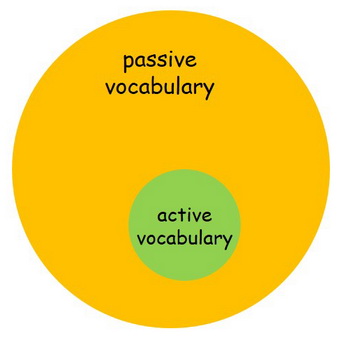



Linguists claim that it’s possible to deal with texts that have 30-40% unknown words. This enables us to engage with difficult material, when it comes to listening and reading, with the goal of general comprehension. What we need to learn to do is to try to infer the meaning of words which we do not productively know from the context which surrounds them. In short, what you need is not to depend on the meaning of every single word when it comes to listening and reading comprehension.
What we will be aiming at at CPE level is a graded knowledge of words:
- "The active vocabulary obviously consists of words that we know 'better' than those that constitute our passive vocabulary. The same distinction holds for native speakers, who also actively use only a subset of the words they are familiar with. Another instance of graded knowledge of words is the fact that, even as native speakers, we often only know that we have heard or read a certain word before, but do not know what it means."
- (Ingo Plag, Word-Formation in English. Cambridge University. Press, 2003)
It is observed that an undergraduate student has 3,000 to 5,000 active vocabulary whereas the same student has 5,000 to 10,000 passive vocabulary.
Good language learners must know the difference between vocabulary which they only need for recognition purposes and the words which they need to produce the language they are learning.
They should also be aware of:
They should also be aware of:
*the frequency of use of the words and the need to concentrate on acquiring high-frequency words.
*the applicability of words related to different contexts – selection of vocabulary items is very important because not everything can be learnt!
*the register of the words they are learning in order to use them or link them to the appropriate situations.
*the associations and connections which exist among the words they learn to recognize or to produce: word families, word formation principles, derivations, connotation and collocations are features which are learned at advanced levels of language learning.
*the register of the words they are learning in order to use them or link them to the appropriate situations.
*the associations and connections which exist among the words they learn to recognize or to produce: word families, word formation principles, derivations, connotation and collocations are features which are learned at advanced levels of language learning.
*the need to guess or infer the meaning of new words from their context to enable themselves to aim for comprehension with autonomy and confidence.